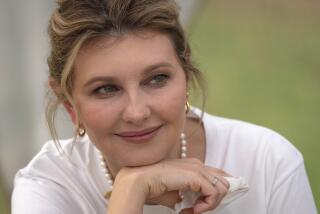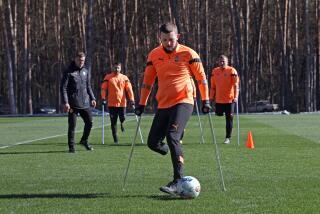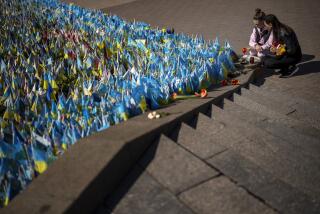In Ravaged Croatia, a Reunion in the Ruins : Balkans: Expatriate in Canoga Park rejoins his family and witnesses his homeland’s catastrophe.
OSIJEK, Croatia — Civil war in the former Yugoslavia has scarred both Zvonko Kutlesa’s country and his family these last two years.
It has made refugees of cousins and aunts, soldiers of friends and in-laws, has devastated the ancient landscape and culture of this region and has split Kutlesa’s own young family between two continents.
As he travels by rail toward a reunion with his pregnant wife and two small children in the eastern front-line city of Osijek, old villages and farmland rush past his window seemingly untouched by time or war. Yet he feels a mix of euphoria, melancholy and anger as he journeys far from his home in Canoga Park across newly independent Croatia.
Just last night, his mother had told him of more destruction at his childhood home of Prijedor, Bosnia, where Serbian occupation forces have leveled the Catholic church to make room for a parking lot.
“They took a piece of my childhood,” Kutlesa says quietly. “I’m sure I’m not going to Prijedor anymore. That’s life--you have to accept that.
“In Prijedor, three nations lived together, three religions,” he says of the Croatians, Bosnians and Serbians, the Catholics, Muslims and Orthodox, who have been locked in violent conflict since 1991. “Now everything’s changed. When you are sleeping and the dreams come from your childhood, the next day you are sick.”
After five years of living and working in the United States and finding some success with a small construction business in Canoga Park, Kutlesa, 38, had hoped this trip would finally bring him home permanently. A trained civil engineer, he expected to participate in the rebuilding of Croatia. But the weak economy here has made jobs scarce, meaning he’ll be forced to return to Los Angeles by August to earn the money his parents, wife and family desperately need.
For Kutlesa, there would be trips to the front in the days ahead, visits to local refugee camps for Croatians and Bosnians, talks with retired men contemplating the prospect of rebuilding their destroyed homes without materials or money. First, though, he would be with his family again in Osijek, a small, elegant city of about 100,000 inhabitants, threatened on three sides by Serbian forces. Many here expect the ravages of war to return yet again.
That lingering threat seems far away the moment Kutlesa leaps from the train at the sight of his wife, Vlasta, and daughters Maya, 8, and 16-month-old Dorotea. He looks very much the casual Southern Californian in his Ray-Bans, Reeboks and baseball cap as he runs toward them, his thick mustache only partially obscuring a smile. It is their first embrace since December, when Vlasta returned to her job as a specialist in brain infections at Osijek Hospital, after a year of living with her husband in the San Fernando Valley.
She had been unhappy in Los Angeles. This professional woman found herself isolated in their apartment, with few English skills, unable to legally practice medicine in the United States without undertaking two years of study and exams. And then there was the war, every night on television. “It was terrible,” Vlasta remembers. “We were separated from relatives. I was worried.”
For most of those 19 months after their Los Angeles wedding in 1991, “I stayed all the time at home,” sometimes walking to the park with the baby and Maya, her daughter from a previous marriage. “It was a prison for me.”
Like many Croatian expatriates in Southern California, the Kutlesas were moved by the war at home, giving what they could to charities through St. Anthony’s Catholic Church in downtown Los Angeles. Kutlesa became president of the Croatian Benevolent Society, a 70-member local group that gathered tons of food, clothing and medicine for eastern Croatia, one of the hardest-hit areas of the war. And he was spending more and more nights at meetings in San Pedro, after long days at work.
“It happened many times that (Vlasta) was upset because I didn’t spend a lot of time with my family,” Kutlesa says.
On New Year’s Eve, drawn partly by a physician’s sense of duty to her troubled country and partly by the feeling that Croatia was where she belonged, Vlasta left for Osijek with the children.
They planned for Zvonko to follow a few months later. “But things change very quickly,” he says, mulling the financial concerns that will compel him to return to Los Angeles.
Among those concerns is support for an extended family of 15 cousins, aunts and uncles from Bosnia whom the war has transformed into refugees. One cousin is staying with Kutlesa’s parents in Zagreb, the Croatian capital, after a dangerous trip through Serbia and Hungary. Others are missing.
Outside the train station, Kutlesa is again reminded of the tragedy he had only witnessed helplessly from Canoga Park. The open wounds of this civil war sparked by Croatia’s declaration of independence from Yugoslavia on June 25, 1991, are scattered everywhere in the old city. A year-old cease-fire between Croats and Serbs has spared Osijek further mortar attacks, though automatic gunfire is often heard in the distance.
The city stands on the south bank of the river Drava, which acts as a natural defense and dividing line against Serb forces now holding the lush Baranja region to the north. United Nations Protection Force troops from Belgium patrol the area. Last summer, a fisherman was killed by a sniper as he glided along the Drava, but swimmers and sunbathers have slowly returned to the river.
In town, young men in battle fatigues struggle across wide streets on crutches and incomplete limbs, past tall 19th-Century houses gutted by fire. Others spend the afternoons watching subtitled reruns of the American soap opera “Santa Barbara,” for a display of Southern California decadence and misery.
Vlasta has been living on a road to nowhere, a four-lane street called Vukovarska. It was once a major thoroughfare to Vukovar but is now a dead end, stopping miles short of the devastated city held by the Serbs. During the war, Vlasta’s house was hit by mortar fire, destroying the roof and windows. Across the street, another house, a charred shell without a roof, is beyond repair.
“They didn’t have a particular target, so they started shelling civilians,” Zvonko says, throwing up his hands on his first full day back with his family. He is blurry-eyed this drizzly morning as he steps outside to walk Maya to school. “What kind of military target can you have here? Look, it’s only houses!”
By the time he and Maya arrive, youngsters are already chattering on the steps in their colorful T-shirts and backpacks, oblivious to the shrapnel damage around them. It is everywhere here, in spite of massive repair work--in halls and classrooms, walls and ceilings. During the war, this primary school was hit four times. Last year, children were in class for only two months.
Six hundred and seventy students attend, including 200 refugees, just one mile from the front.
“Most of the children here are by themselves,” says Elizabeta Banpin, an English teacher. “Their parents are in Germany or Austria working, and they are here with their relatives. Of course, that’s a trauma for them, and that’s reflected in the work they do here.”
Others have had parents killed. One boy watched his sister die in a mortar explosion, and later attempted suicide with pills. One 12-year-old girl was killed just outside the school while running to pick up a videotape from a friend.
Thunder rumbles outside, and Banpin laughs wearily. “When we hear this we are all frightened. We think, ‘ That is the sound --maybe they are starting again.’ ”
It’s a common sentiment in Osijek. The entire city had been a battlefield, and now, with the cease-fire, its population rests uneasily between war and peace. Serbian forces are still within easy mortar range, with only a thin line of civilian police and U.N. troops protecting the new border.
Across the Drava one rainy night, not 50 yards from the thick oak forest that marks the beginning of Serbian-held Baranja, a quintet of young Croatian police reserves stands guard. Some huddle around a fire outside or sit with a deck of cards in the cramped guard shack.
One of them, a 31-year-old father of two, relaxes over his meal of bread and onion. Like the others, he had lived in Baranja and worked in a factory before the war. Now he wears a blue-gray uniform, collects bullets pulled from the trees, and waits to go home. “We feel good here,” he says. “But we feel insecure, too.”
*
Vlasta Kutlesa is due to deliver her third child in just a few weeks, but moves her pregnant form energetically and gracefully through the halls and offices of the department of infectious diseases. She’s come with her family to Osijek Hospital for a visit. Friends and colleagues greet her with smiles and kisses, doting over young Maya and the baby.
She arrived in Croatia after the cease-fire, but missed little of the war’s aftermath. She still remembers one young soldier who arrived at the hospital missing both eyes and his right arm. “I cried,” she says.
Before the cease-fire, almost 320 bombs had fallen on the hospital complex, one of the largest medical centers in the country, with 1,500 beds.
During the war, 110 doctors left the hospital, some for their own safety and others for the Serbian side. Among the latter was Vlasta’s closest friend. The two had traveled together, co-written medical articles, taken their children to parties and the theater. It had been a friendship far from the caldron of politics and ethnic animosity.
“The bridge of friendship is broken,” Vlasta says. “I cannot stay cold of all this. I am human, a doctor, an altruist. I’ve seen soldiers, children, civilians die.”
On one of their weekend outings since his return, Kutlesa and the family visit Volpovo, to see the old castle and walk through Narodni Park, where Vlasta’s parents had their first kiss. Even on these quiet streets are scars of war.
Kutlesa pushes the baby stroller down a pebbly path, while Maya makes the usual jokes about her father’s English.
The front line is only a mile away. Parked nearby is a military truck loaded with potatoes for the families of wounded soldiers, donated from Germany and Hungary. The Kutlesas chat with a young soldier in the park, and he tells them how the village brought out a World War I German machine gun from storage when the newest war came.
The soldier, 24, was born here. At his side he carries the small Serbian-made pistol his father bought back in 1960. “I’m not a warrior,” he says. “I like riding a motorcycle and women more.”
Just a few years ago, this soldier with the cropped hair and snug fatigues wore a Mohawk, listened to gloomy post-punk music and rode a BMW motorcycle.
Despite the bleakness, Vlasta can still smile contentedly beneath her short, tousled hair. She’s with her family today, finally. The couple have spent nearly as much time separated by continents and time zones, work schedules and relief projects, as they have been together since their marriage.
“For me,” Vlasta says, “now is the honeymoon.”
More to Read
Sign up for Essential California
The most important California stories and recommendations in your inbox every morning.
You may occasionally receive promotional content from the Los Angeles Times.











